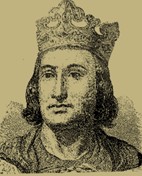
Phillippe Auguste
by Crystal Knight
Phillippe Auguste was born on August 21, 1165, in Gonesse, right near Paris, and he died in the year of 1223. He became King of France in the year of 1180, and ruled about three-fourths of the area of modern France. During his reign the French domain became much stronger and bigger. When Phillippe Auguste was 15 years old his father, Louis VII, died and Phillippe was crowned as king with the support of the important lords of Flanders, Champagne, and Burgundy.
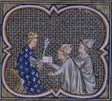
Phillippe Auguste being crowned
After he became king, Phillippe Auguste left for the Third Crusades in the year of 1190, but returned one year later after an argument with King Richard I of England (Richard the Lionhearted) who was also on the Crusade. After Richardís death, his brother became King John of England and invaded France. Phillippe won the battle of Bouvines against the English in 1214.
Phillippe married Isabella de Hainaut, but she died in 1190. He next married Princess Ingeburg of Denmark in 1193, but he got rid of her to marry Agnes de Marenie. However, Phillippe soon tired of Agnes and returned to Ingeburg.
During Phillippe Augusteís rule he started some very important institutions. Notre Dame was a church that Phillippe built during his rule, and Phillippe also started the Univerity of Paris. His children got their education there. Phillippe thought that their education was very important because he never felt had gotten a good education.
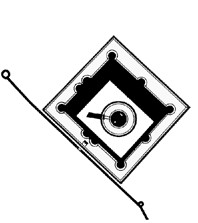
The original Louvre Plan
The Louvre is now seven blocks long and a world famous museum today. It was originally built by Phillippe Auguste. The origins of the name is still unknown, but the king decided he wanted to build an impregnable fortress where the defense of the city was the weakest. The Louvre was built at the end of the wall surrounding the city and touched the river that ran through it.
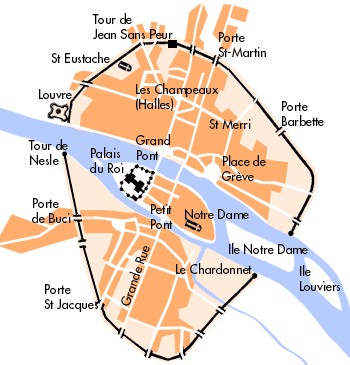
City of Paris at the time of Philip Augusts
At this location he built a fortified castle with a dungeon, that was surrounded by a wall. The dungeons shape was a huge square tower, whose shape can still be found on the ground. It was about 32 yards high with a cone-shape roof. The walls were 4.20 yards thick at the bottom.
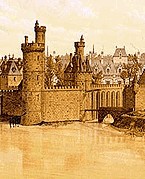
City Walls
Encarta Encyclopedia 99 (CD-ROM) Microsoft, 1999
"Notre Dame de Paris" @ http://www.learn.columbia.edu/notre-dame/ - 12/14/99
"Paris at the time of Phillip Augustus" @ http://www.phillippe-auguste.com/uk/inddex.html - 12/14/99
"Phillippe Auguste" @ http://www.phillippe-auguste.com/uk/inddex.html, 1/5/00
Picture Credit:
Picture #1 - "Phillippe Auguste" from: http://www.phillippe-auguste.com/uk/index.html
Picture #2 - "Phillip Augustus being crowned" from: http://www.phillippe-auguste.com/uk/index.html
Picture #3 - "The Plan of the Louve" from: http://www.learn.columbia.edu/notre-dame/
Picture #4 - "The City of Paris" from: http://www.learn.columbia.edu/notre-dame/
Picture #5 - "The City Wall" from: http://www.learn.columbia.edu/notre-dame/